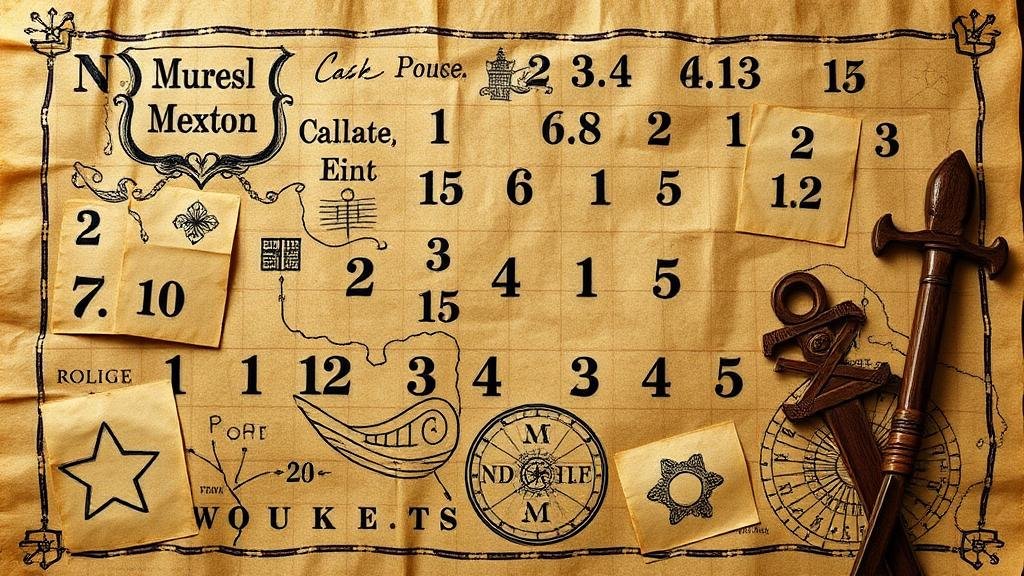Interpreting Numbers and Letters Found on Pirate Treasure Maps
Interpreting Numbers and Letters Found on Pirate Treasure Maps
Pirate treasure maps have long fascinated adventurers, historians, and enthusiasts alike. The allure of hidden treasure often hinges on interpreting the cryptic symbols, including numbers and letters, that many such maps feature. This article explores the nuances of deciphering these elements, providing insights into methodologies, historical context, and practical applications for modern treasure hunters.
The Role of Numbers on Treasure Maps
Numerical symbols on pirate treasure maps frequently serve several purposes, including indicating distances, coordinates, and other critical geographic information. Understanding the significance of these numbers is essential for successful treasure hunting.
- Distance Measurement: Numbers often represent the distance to take from a landmark. For example, “100 paces north of the old oak tree†suggests the treasure is located directly relative to the specified tree.
- Coordinate Representation: Some maps use a coordinate system, similar to modern GPS coordinates, where numbers indicate latitude and longitude. For example, the coordinates “25° N, 80° W†might pinpoint a location in the Caribbean.
- Depth Indicators: Certain maps denote depth measurements, especially in maritime contexts. Height may refer to the depth one must dive or dig to find the treasure.
For example, the famous 17th-century pirate captain William Kidd is known to have buried treasure in locations that were described using specific distance metrics in his maps. Understanding how to interpret these numerical clues not only guides enthusiasts in their pursuits but also adds a layer of authenticity to the treasure hunting experience.
The Significance of Letters on Treasure Maps
Letters, much like numbers, are instrumental in deciphering the meaning behind various elements on a map. They often provide context about directions, landmarks, or other essentials needed to locate treasure.
- Landmark Identification: Letters may signify specific landmarks or important sites nearby. For example, “A†might represent “the Abandoned Castle†or “C†for “Cove,†guiding treasure seekers to significant nearby markers.
- Direction Clarity: Letters can denote cardinal directions, such as N for north and S for south, essential for navigational accuracy.
- Legend and Key: Many maps include a key that explains letter notations. For example, “T†could stand for “Treasure,†indicating to treasure hunters where to focus their efforts.
Consider the infamous treasure map of Captain Morgan, which includes various letters that refer not just to locations but to other pirates territories. The ability to link these letters to real historical locations ultimately enhances the search for buried riches.
Case Studies in Map Interpretation
Several case studies illustrate the successful interpretation of numbers and letters on pirate maps. One of the most notable cases involves the famed “Oak Island†treasure hunt. Participants have used clues from historical maps, including both letters and numbers, leading them on complex searches for buried treasure.
- The Money Pit: Explorations have often revolved around a series of numbers and letters etched into early maps that point to layers of soil and depth measurements linked to treasure.
- Florida’s Treasure Coast: Research into Spanish treasure maps, supplemented by historical records, has allowed adventurers to pinpoint treasure sites accurately by following lettered landmarks and numeric distances.
These case studies underscore the practical importance of mastering the art of interpretation. They demonstrate that treasure hunting requires not only a spirit of adventure but also analytical skills to decode historical clues.
Practical Application for Modern Treasure Hunters
For those interested in engaging with treasure hunting today, understanding these concepts can be rewarding. Developers of treasure maps often blend historical data with creative storytelling, resulting in maps that require careful scrutiny and analysis.
- Utilizing a Compass: Modern treasure seekers should bring a compass and a reliable map to help navigate based on the numbers and letters they encounter on the treasure map.
- Research is Key: Conducting thorough research on historical contexts linked to the pirate maps can provide treasure seekers invaluable background knowledge. Utilizing local libraries or online databases could reveal insights into how to interpret the peculiar symbols.
- Join Community Groups: Engaging in local or online treasure hunting communities can provide invaluable tips and perspectives from seasoned adventurers.
To wrap up, the patterns of numbers and letters on pirate treasure maps hold significant meaning that, when properly interpreted, can lead to potentially rewarding discoveries. As you embark on your treasure-seeking journey, sharpening your interpretative skills will enhance your success and enjoy the adventure that lies ahead.


